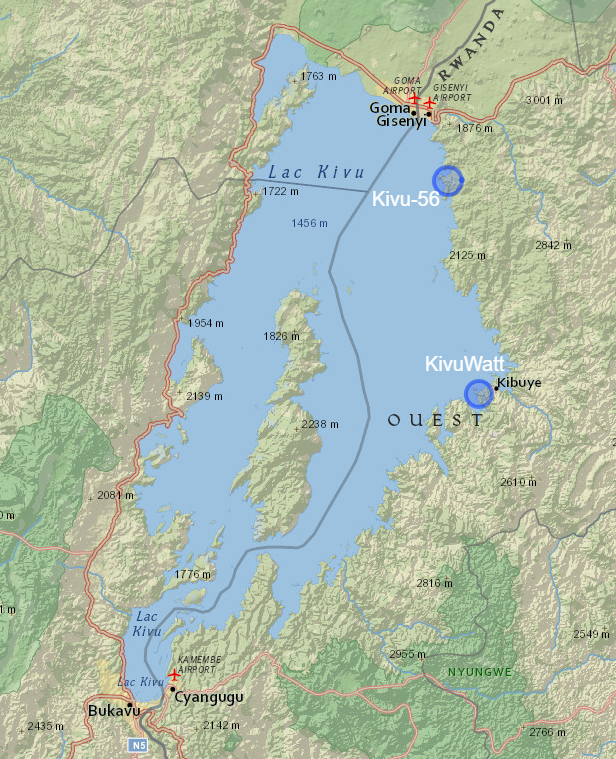Danger and possibility under Lake Kivu
- Beneath the surface of the lake lies 60 billion cubic meters (bcm) of methane gas and 300 bcm of carbon dioxide originating from local volcanic activity.1 Without intervention, a gas eruption could occur within the next century.2
- Located between Rwanda and the Democratic Republic of the Congo, over 2 million people live on the shores of the lake. Similar lake-gas eruptions, though significantly smaller and in less densely populated areas, happened in Cameroon in 1984 and 1986.3 The second killed over 1000 people.
Two problems, one solution
An eruption can be prevented by extracting the gas, discarding the CO2, and using the methane gas — thus, turning a potential disaster into a tangible benefit.
- Only 30% of Rwanda’s population has access to electricity, and even for those with power, supply is estimated to be 22% more expensive compared to other countries in East Africa.4 In addition, Rwanda is often plagued with power-outages and poor quality supply.5
- The government is currently working with a local company, Gasmeth Energy, as well as foreign investors – Contour Global and Symbion – to extract Lake Kivu gas for electricity generation that will eventually total over 100MW.6
- These gas generation facilities could displace significant amounts of expensive imported diesel.7 And gas that isn’t used for diesel displacement, or to satisfy future demand, Rwanda can export or find other productive uses: transportation fuel, CNG for clean cooking, and direct inputs for industrial processes like cement and fertilizer production.
Challenges of extracting methane gas for productive uses
- Technology is novel. Lake Kivu is a meromictic lake, which means that it has a second, lower layer of high-pressure water that contains dissolved methane and CO2. To extract this gas requires using a barge that pumps water from this second layer, and separates the gas out. This runs several risks to the chemical and temperature balances within the lake. While lack of drilling usually keeps capex low, since this novel technology can only be applied in this single lake, there will be limited economies of scale.
- Financing challenges. Utilities in Rwanda are cash-strapped and cannot fund the entire required investment. This means investment will continue to come largely from foreign sources.
- Tariff structures. The government is aware of possible alternative productive uses of Lake Kivu gas and it is procuring support for new tariff design to define a pricing strategy that is affordable and competitive.
- Regulatory framework. Current regulations primarily focus on electricity production from Lake Kivu methane and not directly on the extraction of the methane. There is no policy framework to guide the management, regulation, and use of the resource other than power generation.
- Troubled international relations. Rwanda and its neighbor, the Democratic Republic of the Congo, signed a MoU to encourage cooperation on the protection of the lake and extraction of methane gas in a way that ensures environmental and population safety. Yet the two countries have a fraught past and disagreements may arise regarding the sharing of the resource between Rwanda and the DRC. The gas could provide a basis for a productive relationship.
- Environmental Concerns. The population near the lake have already expressed concerns regarding the environmental impacts of the extraction of methane gas, such as groundwater and surface water contamination as well as the destruction of aquatic life.
The Future: The reserves of methane gas provide challenges and opportunities for Rwanda. Further analysis of markets and infrastructure is needed to meet domestic need, future economic development, and to quantify the export potential.
FIGURE 1: Map of Lake Kivu showing location of the two ongoing projects

Endnotes
- “Methane Gas in Rwanda.” Mininfra.gov.rw, REPUBLIC OF RWANDA MINISTRY OF INFRASTRUCTURE.
- “Kivu Watt Power Plant ESIA”. MIGA, ContourGlobal KivuWatt Ltd ESIA, 28 Oct. 2009,
- Rosen, Jonathan W. “Lake Kivu’s Great Gas Gamble”. MIT Technology Review, 30 Dec. 2017.
- Bimenyimna, Samuel, et al. “The State of the Power Sector in Rwanda: A Progressive Sector With Ambitious Targets”. Frontiers in Energy Research, Energy Systems and Policy, 21 June 2018.l
- World Bank, Sustainable Energy for All ( SE4ALL ) database from the SE4ALL Global Tracking Framework led jointly by the World Bank, International Energy Agency, and the Energy Sector Management Assistance Program. Access to Electricity (%). https://data.worldbank.org/indicator/EG.ELC.ACCS.ZS?locations=RW
- “KivuWatt.” ContourGlobal, www.contourglobal.com/asset/kivuwatt;“Rwanda Kivu-56 | 56MW” Symbion Power, www.symbion-power.com/rwanda-kiv/
- “Energy Sector Strategic Plan”. Republic of Rwanda, Ministry of Infrastructure. 2018.
